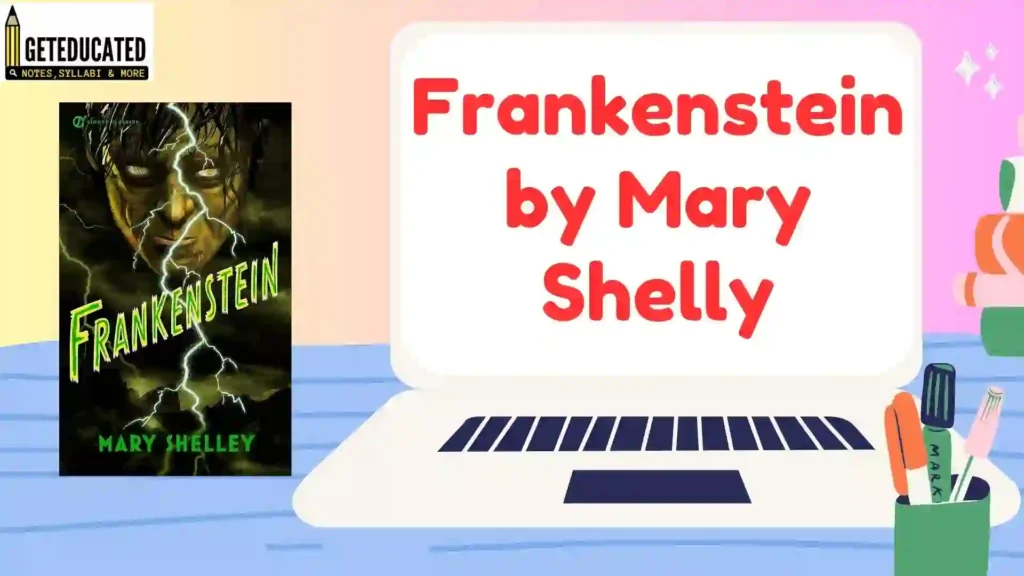
Narrative Style in Frankenstein : Mary Shelley’s Frankenstein is written by deploying the flashback technique which has been compared by critics to a Chinese box-a structure of stories within stories. The major framework is provided by the first narrator-Robert Walton whose expedition to explore the Arctic region brings him into contact with the principal narrator Victor Frankenstein who is found almost dead is nursed back to life. Victor narrates his quest to Walton and within Victor’s narrative is the narrative of the monster he had created; and again the narrative is taken up by Victor till he is found in the icy regions by Walton. From point till Victor’s death, the narrative is taken up by Robert Walton again and brings the novel to an end. There are many narratives within Victor’s and that of the monster. Thus the novel anticipates Emile Bronte’s Wuthering Heights published in 1847. Once the outer layer is peeled off, another layer comes followed by yet another and yet another. What is most admirable is the skillful management of the material into an artistically woven fabric by Mary Shelley, just a nineteen year old girl at that.
Though Frankenstein is now customarily classified as a horror story (albeit the first and purest of its kind), it is interesting to note that Wollstonecraft Shelley’s contemporaries regarded it as a serious novel of ideas. It served as an illustration of many of the tenets of William Godwin’s philosophy, and did more to promote his ideas than his own work ever did. The novel does not, however, subscribe to all of Godwin’s precepts. It stands in explicit opposition to the idea that man can achieve perfection in fact; it argues that any attempt to attain perfection will ultimately end in ruin.
Set in the icy waters of the polar north, Shelley’s Frankenstein is a tale friend. within a tale. On a voyage of scientific exploration, Robert Walton comes across the half-dead Victor Frankenstein and pulls him aboard his vessel. Frankenstein recounts a nightmarish tale of having created a monster that caused destruction and murdered Frankenstein’s fiancée and a Walton learns that Frankenstein is now searching for the monster, intent on destroying it in retribution, but the scientist demonstrates no sense of responsibility for what he has set in motion. As soon as he has finished telling the story, Frankenstein dies.
Immediately afterward, the monster himself boards the ship and tells the captain that he regrets his actions-but his apology is too late for Victor Frankenstein to witness. The creature tells Walton it sought affection, but its appearance inspired revulsion in everyone it met. “Once I falsely hoped to meet with beings, who, pardoning my outward form, would love me for the excellent qualities which I was capable of unfolding…. But now crime has degraded me beneath the meanest animal. No guilt, no mischief, no malignity, no misery, can be found comparable to mine…. [T]he fallen angel becomes a malignant devil.” The novel concludes with the creature saying he will build a funeral pyre and immolate himself. He disappears, “lost in darkness and distance.”
The narrative structure of Frankenstein is very complex. It involves framed or embedded narratives. This has been called a Chinese-box structure of stories within stories. First we have the frame narrative of the four letters written by Walton to his sister, Mrs. Seville. At this stage, we have epistolary narrative-that is narrative through letters. This is dropped, however, as we move to an embedded narrative: Victor’s account of his life is narrated to Walton. Victor’s narrative then in turn serves to frame the creature’s embedded narrative. In that the creature he recounts his tale, and that of the De Lacey family, to Victor. Victor in his turn recounts it to Walton. The narrative then reverts to Frankenstein until his death, when Walton takes over. Now we return to the frame narrative of Walton for the conclusion of the story. Glennis Byron says that the anarchic energy of the text is formally restrained by this tight structure. In this sense, it invites comparison with Emily Bronte’s Wuthering Heights, another nineteenth- century novel with a similarly complicated and tight narrative structure closing the anarchic rebellion of the characters against the established order The Problem With Deploying The Chinese-Box Analogy.
Suggested Reading :
Theme and Plot of Frankenstein by Mary Shelley
The problem with employing the Chinese-box analogy to describe the narrative structure of Frankenstein is that this term tends to imply that each story is separate, complete in itself. The narratives are not linear or complete however; we are not taken directly from the beginning of one narrator’s tale to the end and then move the tale of another narrator. To cite an example, Walton’s initial narrative provides us with an account of Victor’s predicament. In a linear narrative, that would come near the end of Victor’s narration. The narratives in Frankenstein are frame narrative. Instead of being complete and whole in themselves are interrelated and independent.
The convention of frame narrative is that we accept that the stories contained within the frame work are remembered and transcribed virtually word for word by the frame narrator. We might, then ask to what degree differences in voice are effaced by this process, if voice considered in its admittedly rather vague sense of the features of tone and style.
Is the voice in the monster’s narrative all that distinct that in Walton’s or Victor’s? Are there discernible differences which help to express unique personalities, or there the markers which would allow us to distinguish between narrators effaced by the frame narrator’s recounting of the other stories? Some critics have suggested that, since all the narratives come to us from the frame narrator, distinctions between voices are blurred and the question basic to the most narrative theories, who is speaking, becomes problematical. Frankenstein is written in the first person narrative, but do we have one or three first-person narrators?
The structure also draws attention to the presence of a listener or narrate for each narrator, encouraging the reader to consider what purpose each narrative has in speaking, what influence he is attempting to exert over the narrate. Their stories, at least in the case of Victor and the monster, are easily told in a way designed to achieve a specific effect. The monster’s narrative is an attempt to persuade Victor to assume his responsibilities towards his creation and to construct a mate for him. What strategies does the monster use? How does he emphasise his point about the need for companionship and love? Victor similarly has specific aims in telling his tale to Walton; he may begin by claiming to use his fate as a warning to Walton, but by the time his narrative concludes, his real purpose has become clear. Just as the monster employs his eloquence to make Victor promise him a mate, so Victor promises to take over his quest to destroy the monster.
We might also examine how reliable the narrators are, both in their assessment of themselves and in their interpretation of other characters and situations. When Victor compares his feelings to those of Justine, condemned to be executed, and assures us that the “tortures of the accused did not equal mine”, do we perhaps feel a little self-absorbed to be the best interpreter of other people’s feelings? Does Victor even really understand his own fears? He tells us that he does not want to rush into the marriage with Elizabeth because he first has to deal with the problem of the monster, but his dreams suggest that there is more to it than this, that he would rather dabble with test tubes than procreate in the normal way.
The narrative style further serves to invite us to look for echoes and parallels which link the stories together and simultaneously identify differences between the three characters. Walton’s ambitions, for example make him a potential Frankenstein, and like him he too is isolated and alienated from the domestic world. However, Walton truly seems to long for the affection and companionship that Victor spurns, and in this scene he is more closely linked to the monster. In addition, no matter how alienated Walton may feel in the icy wastes of the Artic, he has his crew, a community of sorts who prevent him from indulging in the kind of rampant individualism that destroys Victor.
Finally, we need to examine whether there is a proper end for the novel or if it remains open-ended. As it is difficult to fix one meaning or message to Frankenstein, then on the level of the interpretation there is no proper closure. Although we seem to come to a decisive with the death of Victor and Walton’s decision to return home, there is actually no real closure on the level of the plot either. The monster vows to immolate himself. As Fred Botting points out in Making Monsters, however, “from the textual evidence the reader can never know what happens to the monster”. This ending is, for us, for ever deferred, something projected in the future, and Mary Shelley leaves the reader, like the monster, “lost in darkness and distance”.

[…] Mary Shelley’s Frankenstein is written by deploying the flashback technique which has been compared by critics to a Chinese box-a structure of stories within stories. The major framework is provided by the first narrator-Robert Walton whose expedition to explore the Arctic region brings him into contact with the principal narrator Victor Frankenstein who is found almost dead is nursed back to life. Victor narrates his quest to Walton and within Victor’s narrative is the narrative of the monster he had created; and again the narrative is taken up by Victor till he is found in the icy regions by Walton. From point till Victor’s death, the narrative is taken up by Robert Walton again and brings the novel to an end. There are many narratives within Victor’s and that of the monster. Thus the novel anticipates Emile Bronte’s Wuthering Heights published in 1847. Once the outer layer is peeled off, another layer comes followed by yet another and yet another. What is most admirable is the skillful management of the material into an artistically woven fabric by Mary Shelley, just a nineteen year old girl at that. …(Read More) […]
[…] Narrative Technique in Frankenstein by Mary Shelley […]